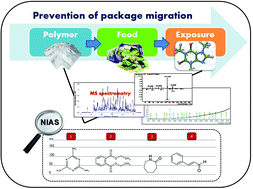Characterization of non-intentionally added substances (NIAS) and zinc oxide nanoparticle release from evaluation of new antimicrobial food contact materials by both LC-QTOF-MS, GC-QTOF-MS and ICP-MS†
Abstract
The migration of non-intentionally added substances (NIAS; namely organic chemicals) and added metal oxide nanoparticles from new active nanomaterials intended for use as food contact materials (FCMs) has been determined by a mass spectrometry-based methodology. The FCMs consist of polypropylene (PP)-based nanocomposites functionalized with zinc oxide nanoparticles (ZnO NPs) as the antimicrobial agent. This work presents a multi-analytical approach incorporating ICP-MS (inductively coupled plasma mass spectrometry), GC-QTOF-MS (gas chromatography coupled to quadrupole-time-of-flight mass spectrometry) and LC-QTOF-MS (liquid chromatography coupled to quadrupole-time-of-flight mass spectrometry) platforms. The screening approach for investigating both the GC- and LC-amenable NIAS consisted of initial peak detection and structural characterization based on accurate mass acquisition of both the full-scan and fragmentation spectra. The workflow for the unknown screening comprised retrospective analysis and data processing using both a mass spectral library and databases. Migration testing, based on standard operating conditions established by EU legislation, provided tentative identification of both LC-amenable NIAS: 2,4,6 triamino-1,3,5-triazine; azepan-2-one; (2E)-3-phenylprop-2-enal, and GC-amenable NIAS: diethyl phthalate (DEP). To determine the optimal antimicrobial FCM performance, we evaluated the release of ZnO NPs from different PPR-based nanocomposites. Out of the nanopolymers evaluated, a film consisting of PP, polylimonene (PL) and ZnO NPs, in wt% (92/5/3), proved to be a suitable contact material with improved functionality.


 Please wait while we load your content...
Please wait while we load your content...